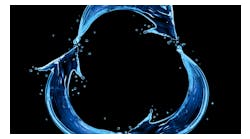Q
Hello Professor,
We have a well water customer in Alberta, Canada whose water we can’t treat to their satisfaction. I have attached three lab reports. One is the raw well water and includes total coliforms and fecal coliforms. One sample is the water after the POE (point-of-entry) treatment and does not include the bacteria tests. Another analysis is the final RO (reverse osmosis) product water and does include the total and fecal coliforms.
The POE treatment consists of a fine-mesh resin water softener to soften and remove traces of iron, a 20-micron sediment filter and a 1.25 cubic foot mixed bed of GAC and catalytic carbon for color and odor removal.
The POU (point-of-use) treatment consists of a one gpm UV (ultraviolet) unit, which feeds a five-stage RO system with a booster pump and a 40 psi pressure tank. Final polishing of the water leading to the faucet is a mixed bed DI (deionizer) cartridge. This was added as a last-resort “catch all” when the RO water didn’t seem good enough.
The house has a submersible pump and pressure system that runs between 30-50 psi and puts out over eight gpm for backwashing the filters. My client complains of a “lemony” taste in the water from a detergent-free clean water bottle.
Every family member including the dog gets severe diarrhea from the water.
The well has been shocked. All internal components of the RO system, as well as the storage tank, have been thoroughly cleaned and ultimately replaced. They appear normal and the laboratory results seem to verify it. The taste is definitely impacted by whatever this contaminant is. I have verified it myself including conformation of the absence of detergent residue.
I can see by the coliform numbers that we should be considering a whole-home UV system, but it appears unlikely that this is the immediate problem.
– Alberta, Canada
A
The highlights of your water analyses show that the RO has reduced the TDS of 1,502 mg/L and sodium of 303 mg/L to 1.6 mg/L and 0.63 mg/L respectively.
The fine-mesh softener has reduced the hardness from 663 mg/L to eight mg/L. Iron was negligible to begin with. I’m not sure what type of sediment filter you are using or why. The analysis shows only a “few sediments” that could very well be removed by the softener, the carbon filter or the RO prefilter. I raise this question because if you have a 20-micron cartridge filter, it is adding pressure loss to the system and may not have adequate flow rate ability for the backwash flow rate of the GAC filter.
The coliforms are low to begin with but need treating. According to the CDWQG (Canadian Drinking Water Quality Guidelines) all the “finished” water parameters are within the guidelines.
I’m quite sure the lemon-like taste comes from the very acidic pH of 4.9 after the RO. It is typical for pH to drop after RO due to the removal of bicarbonate alkalinity. This water started with a pH of 7.4 and bicarbonate of 1,054 mg/L. The “after RO” analysis shows bicarbonate of 0.39 mg/L. I don’t know if the low pH is also after the DI cartridge. If it is, then the cartridge probably exacerbated the low pH problem. I don’t see any need for the DI. It can only remove additional minerals, which you don’t want, and reduce the pH, which you don’t need. The acidic pH is also low enough to be corrosive to metallic plumbing, tubing, fittings and possibly the faucet.
I would recommend that you remove the 20-micron filter and the DI cartridge. If I’m understanding the system correctly the UV is ahead of the RO. This means that you are disinfecting all the RO feedwater, including the reject water going to the drain. If the UV were placed last in the system, where I normally would want to see it, the flow rate through it would be lower than what it is now, and you would increase the UV contact time thereby gaining deactivation of bacteria. This new UV placement could be just before or after the RO product water storage tank. There is trade-off here which I don’t have enough information to evaluate. The ideal place for disinfection is as close to the point-of-use as possible, i.e., the faucet. However, the UV, as stated above, works more effectively with a lower flow rate and greater contact time. This means that the flow through it would be lower when water passes into the RO product water tank than what it is now.
I think it is worthy here to remember some basic hydraulic principles which apply to the filling of water well pressure tanks and to RO storage tanks. When a well pump or a RO booster pump is pumping into an air-filled tank the pump has its lowest back pressure and its highest flow rate at the beginning of the pump cycle. As the tank fills, the back pressure increases thereby reducing the incoming flow rate. This is usually not very significant when discussing a well pump, but is very important when discussing a RO system. RO relies on pressure differential to be at its best. That is why you are using a RO booster pump. I congratulate you for this choice.
However, think carefully about the back pressure created by your RO tank. Do you really need 40 psi? To move water to a faucet maybe 20 or 30 psi would suffice. Use the lowest pressure in this tank that is acceptable to the customer. Unfortunately I don’t know your booster pump pressure, but the lower the tank pressure, the greater the pressure differential, the better the RO water. The RO makes its poorest water just near the end of the booster pump cycle when the pressure differential is at its lowest.
Quite often a calcium carbonate or calcite cartridge is installed after a RO to raise the pH to an acceptable level of 6.5 to 8.5.
Whether or not you need a whole-house UV depends on where the residents take their drinking water.
Other water constituents that are not included in your analyses are radionuclides, VOCs (volatile organic compounds) and other microbiological species. I don’t intend to favor a particular laboratory, but National Testing Laboratories of Ohio and Michigan specialize in analyzing water for water treatment dealers and end users. You can have other tests, like the ones listed above, performed by them.
This may seem somewhat simplistic but inexpensive. Is it possible to remove someone (or a dog) from the finished water to find out if the diarrhea issue changes?
David M. Bauman, CWS-VI, CI, CCO, is technical editor of Water Technology®and a water treatment consultant in Manitowoc, Wis. He received his B.A. from the University of Illinois in Industrial Design. He can be reached by email at: [email protected].
For past articles in this column and related articles, go to www.WaterTechOnline.comand enter keyword “Professor” in the search box. To pose a question to “Professor POU/POE,” go to www.watertechonline.com, click “Ask the Professor” and follow the instructions.


